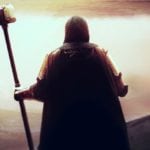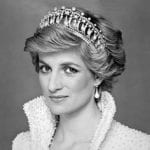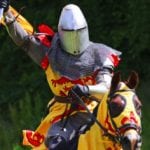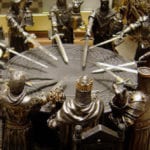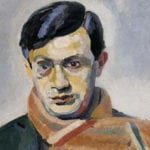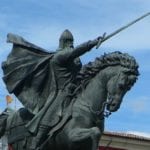 Movies and TV
Movies and TV  Movies and TV
Movies and TV  Politics
Politics The 10 Boldest Coup Attempts of the 21st Century
 Weird Stuff
Weird Stuff 10 Things That Would Have Killed You in the Old West
 Books
Books 10 Pen Names More Famous Than Their Authors
 Creepy
Creepy 10 Unnerving Legends from Around the World
 Movies and TV
Movies and TV 10 Amazing Lead Actor Ideas for Superhero Movies
 Our World
Our World 10 Crazy Facts about Cycads That Might Surprise You
 Technology
Technology 10 World-Changing Examples of Turning Dumb Technology into Smart Technology
 Pop Culture
Pop Culture Ten Celebrities Who Straight-Up Lied on Home Tours
 Animals
Animals 10 Remarkable Things We’ve Recently Learned about Animals
 Movies and TV
Movies and TV 10 Misdirections Directors Used to Manipulate Actors
 Politics
Politics The 10 Boldest Coup Attempts of the 21st Century
 Weird Stuff
Weird Stuff 10 Things That Would Have Killed You in the Old West
Who's Behind Listverse?

Jamie Frater
Head Editor
Jamie founded Listverse due to an insatiable desire to share fascinating, obscure, and bizarre facts. He has been a guest speaker on numerous national radio and television stations and is a five time published author.
More About Us Books
Books 10 Pen Names More Famous Than Their Authors
 Creepy
Creepy 10 Unnerving Legends from Around the World
 Movies and TV
Movies and TV 10 Amazing Lead Actor Ideas for Superhero Movies
 Our World
Our World 10 Crazy Facts about Cycads That Might Surprise You
 Technology
Technology 10 World-Changing Examples of Turning Dumb Technology into Smart Technology
 Pop Culture
Pop Culture Ten Celebrities Who Straight-Up Lied on Home Tours
 Animals
Animals 10 Remarkable Things We’ve Recently Learned about Animals
10 Legendary Mysteries Involving The Knights Templar
Few organizations have captured the world’s collective imagination like the Knights Templar. Certainly, no other group has such a dual image of pious devotion and absolute heresy. They served the poor and the pilgrims. They amassed a huge fortune and all but invented banking. They were put on trial and purged. A lot of fascinating mysteries surrounding the Templars walk the strange line between legend and history.
10The List Of 12 Who Escaped

Templars were famously burned at the stake after being convicted of heresy in the beginning of the 14th century, rounded up and slaughtered wholesale. Less popularly known is the story of the French Templars who escaped. Even the Templar organization as it exists today isn’t sure what the whole story was.
According to the popular story, all the Templars were arrested on Friday the 13th, in October 1307. But it’s also been speculated that some escaped persecution. Estimates of numbers in the order at the time are somewhere around 3,000, but we only have records of the interrogations—and the fate—of about 600 of them. The rest? No idea.
If a massive, coordinated, country-wide series of arrests would have been impossible, many Templars had a chance to get out. Records tell of authorities pursuing some of the escaped knights, and one document in particular has been languishing in French archives for centuries. Only proved authentic recently after handwriting comparison, the document is a list of 12 names that were of particular interest to authorities.
Historians have identified a couple of these names and connected them with the reasons they were of such great interest. Humbert Blanc was a Crusader and master of Auvergne; he was captured and put on trial in 1308, denying all charges (save the secrecy of the order, which he thought unnecessary). Records say he was put in irons, but we’re not sure what happens to him afterward. A couple other names on the list—Renaud de la Folie and Pierre de Boucle—crop up again in trial records, but it’s difficult to tell why they were so important. The spelling of names is less than consistent, making it hard to connect names and deeds.
As for the others on the list, just why they were special targets of the authorities above others is a mystery. One, Guillaume de Lins, even has a question mark next to his name on the list. He’s perhaps Gillierm de Lurs, one of the officers in charge of ceremonies and receptions, but again, spelling gets in the way of establishing anything for sure. We don’t know much about Hugues Daray, either, or Adam de Valencourt, save that he was an elderly man who had, for some reason, joined the Templars twice.
9Debt, An Assassination Plot, And The Arrests

Also on the list of 12 is one man that we know just enough about to raise a whole bunch of other questions—Hugues de Chalon. De Chalon was put on trial after the arrests, but his name shows up in some pretty strange places even before that. A high-ranking officer in Champagne, he met with the pope in 1302 despite orders from the king that they weren’t to respond to the papal summons. History tells us what usually happens to people who disobey the king.
He’s also mentioned in another document associated with Heinrich Finke, the historian who discovered the list. That document refers to a plot to kill the king, supposedly hatched by de Chalon and a handful of unnamed others from the same sect within the Templars. But just what any of it refers to is unknown. We’re not sure what this plot was, if it even existed.
Also mentioned in the document is another name, Gerard de Montclair, and we’re not entirely sure who he is, either. The closest name historians have found in other records is Richard de Montclair from Cyprus, but no one’s been able to connect the two.
A plot to kill the king of France wouldn’t have been entirely out of the question. Philip IV was massively in debt, and he had already been doing quite a bit of creative requisitioning to try to alleviate that debt—some of which had been accumulated before he even took the throne. For starters, he began randomly declaring entire communities heretical and seizing their assets for the crown. He’d already targeted the Jewish community and several Lombard merchants. When that wasn’t enough to finance his campaigns to expand France’s territory, he turned to debasing the French currency at a rate of about two-thirds.
The Templars’ actions somewhat overshadows the rest of the populace’s rioting in protest of the currency adjustment. The riot’s supposed leaders were hanged in the streets as examples. Armed forces were then called in. That was right before the arrests of the Templars. It’s never been proven entirely that their arrests were a money grab, but it seems a likely conclusion.
8What Was The Head Of The Templars?

According to accusations, the Templars had an idol in their possession, a head. While most Templars denied knowing anything about the worship of a head, William of Arreblay claimed to have seen a ceremony in Paris where a silver head sat on an altar at the center of adoration. It was supposedly the head of Saint Ursula—the saint and her 11,000 virgins were reported to have remained faithful in the face of death and torture and were venerated by the Templars for it.
If that’s not unsettling enough, he also stated that the head had two faces. Other descriptions of the head were interpreted as being the head of Baphomet, while others said it was either wood, black and white, or metal.
The idea of the worship of an idol or head of Baphomet is one of the most popularly associated with the accusations presented at the Templar trials, but mention of the name in particular isn’t in any of the official arrest warrants. Supposedly, a version of the name Mahomed was, at some point assigned to the idols.
When things were going all sideways for the Templars, a head was supposedly recovered from their Paris temple. It was said to be a skull covered in silver, wrapped in linen, and labeled “Number 58.” Perhaps one of the 11,000 virgins William of Arreblay described?
It would be easy to dismiss the idea of the mysterious Templar head if the only mentions of it were around the accusations from those trying to brand them as heretics. But other historical accounts indicate that they did have a head, supposedly belonging to Saint Euphemia of Chalcedon.
The Greek orthodox saint was martyred by Emperor Diocletian and was thought to have particular powers against, ironically, heretics. Templar records indicate that during the Fourth Crusade, relics from the saint fell into their possession in Constantinople and were taken to Cyprus. The relic is pretty well recorded and can be traced through the Hospital of St. John and Rhodes, finally ending up in Malta as late as the early 17th century. The Templars used the presence of the skull, which they believed they had received by the grace of God, as evidence that they weren’t a heretical organization.
However, the body of Saint Euphemia rests in the church of St. George in Constantinople, and it’s intact.
7The Skulls Of The Templars

High up in the mountains of France is an area called Luz. It’s the stuff of ancient forests and avalanches, of remote outposts recently only accessible by electric tram, of waterfalls, of mountains, and of lots of snow. It’s so remote that until the French Revolution, it was nearly independent. Even afterward, they held on to freedoms that absolutely didn’t exist elsewhere in France. Today, the whole area is a UNESCO World Heritage Site, in large part because of its layers and layers of human occupation dating back to at least 10,000 BC.
Luz is also home to one of the most well-preserved Templar churches in the world. While the Castle of Saint Marie sits in ruins, not far away is the immaculately preserved parish church, surrounded by crenellated walls, several towers, ramparts, and gateways. Clearly, the church was built by people who weren’t messing about.
The entire thing sits on the edge of the Gavarnie Cirque, a huge valley in the midst of canyons, crags, and mountains. And in the church of Gavarnie, there are 12 skulls, said to be the heads of the Templars who had been living at the fortified Luz church when the order for the Templar execution went out. There are no names, no bodies, and no other information on them, save a legend.
It’s said that every year, the specter of Grand Master de Molay enters the church and asks if there is anyone there who is willing to fight for the order and for the temple. One by one, each of the skulls answers, “None; the temple is destroyed.” While the legend is certainly fanciful, the fascinating story of what happened in the remote, disconnected, and mostly self-governing village to their Templars is long lost.
6What’s Hiding Beneath Rosslyn Chapel?

No location is more closely tied with Templar lore and mysteries than Rosslyn Chapel. Once called the Collegiate Church of St. Matthew and located in Midlothian, Scotland, it’s always been known for its incredible stone carvings and seemingly mystical symbolism. The stories about Rosslyn have been growing for decades and range from the outright bizarre (alien landing spot) to the epic and romantic. (Twelve Templars lie in slumber beneath the chapel, ready to return when the world needs them again.)
Most of the stories come from a combination of the Sinclair family’s ties to the Templars and a work written by Father Richard Hay in the 1700s, where he tells of secrets within the chapel, hidden vaults, and a network of tunnels beneath it that led to the temporary resting place of the 12 knights. With the help of Sir Walter Scott, the stories were taken into that weird place between history and legend.
In 2010, The Glasgow School of Art and Historic Scotland started a project that seemed like it might solve all the mysteries of Rosslyn Chapel for good. The joint effort was to survey the entire site—and other World Heritage Sites—with 3-D scanners. The goal was to not only preserve the details of the chapel in its entirety but also to guide the multimillion-dollar restoration and preservation project that had been laid in place for the site.
It seems like completely scanning the building would clear up any mystery about secret doors, hidden tunnels, or undiscovered chambers, but it’s only made things a little bit more muddled. A vault sits beneath the chapel, but it was likely built in the late 1800s. No knights lie there, but one of the Earls of Rosslyn was buried there in 1937. And one researcher says results from an earlier scan done by the US Navy did go underground. He claims that the results showed a series of tunnels snaking along underground, away from the chapel.
5Beneath Temple Mount

The Templars have long been associated with lost treasure and artifacts like the Ark of the Covenant and the Holy Grail. While most of these theories are definitely in the realm of fiction and fantasy, one of the first Templar outposts had some definite treasure-bearing possibilities. In fact, we think they did one of the first large-scale excavations of the land and tunnels beneath Temple Mount in Jerusalem. Whether it was an accidental excavation that started when they were building their own additions or if they were looking for something in particular is not known. Nor is whether they found something.
In 1118, the Crusaders had been holding Jerusalem for 19 years. The Templars, originally having no real base of operations, received the land and the buildings of the Temple on Mount Moriah from Baldwin the Second, king of Jerusalem. At the time, the buildings there were partially Christian (from Emperor Justinian) and Muslim (from Caliph Omar). It was already documented as a place to store and display relics, as well as being built on the spot where God had appeared to David.
Originally, the Islamic temple was topped with a crescent, but Christian Crusaders tore it down and replaced it with a cross. Once the Templars took possession of the area, they not only took their name from it, but they started some construction projects of their own. The rock beneath the temple’s dome, long held to be the place where an angel had descended, had been left untouched for 15 years before the addition of an altar.
Here, the purpose of the Templars underwent a bit of a change. The original purpose of the group was to protect pilgrims on their way to the Holy Land, and once they were there, they decided that their role as protectors should extend to the holy places and relics of Christianity as well. Not long after, the newly established order had the backing and support of the king of Jerusalem, along with a host of European nobility and clergy.
Just how the Templars managed to get so big and get so much support so quickly is up for debate. They certainly had their supporters, but it’s also been suggested that when they moved in, they found some valuable relics that showed just how much God approved of their fledgling order.
That’s not to say that they found the Holy Grail or the Ark of the Covenant, but questions remain. No actual traces of the First Temple had been found on the site. Recently, excavations uncovered an easily overlooked but important piece of potential evidence: a seal imprinted with the name of one of the First Temple’s chief administrators. While it confirms a lot about what was on the location, it also brings up more questions about what was uncovered and spirited away.
4Henry Sinclair’s Trip To The New World
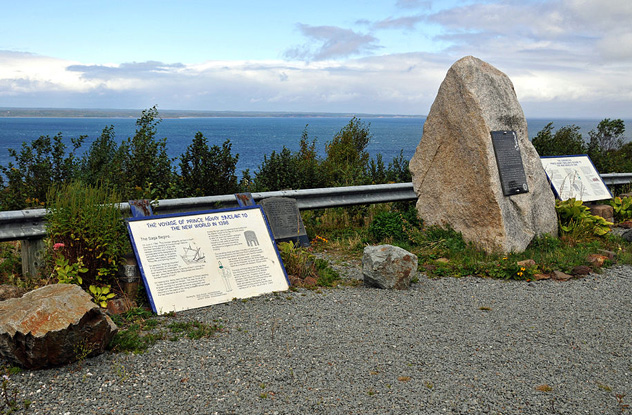
The Knights Templar were one of the groups long said to have beaten Columbus to the Americas. The theory is built on rather shaky ground, though, with a major piece of evidence being a 1558 Venetian manuscript that told the family history of the Zenos.
According to the story, Italian navigators Nicolo and Antonio Zeno recorded the details of a journey that started in 1380. It unfolded through a series of letters, in which they told of their experiences on an island they called Frislanda. Nicolo was the first there, shipwrecked and stranded, when a mysterious figure came to his rescue. Nicolo called him Prince Zichmni, painting him as a great warrior and inviting his brother to come join him in his service to the warrior prince. Supposedly, they spent the next 14 years fighting for the prince before learning of a group of fishermen that had returned after being gone for 25 years. They told of a land to the west, full of savages and strange animals, and Zichmni headed in that direction.
The story of Henry Sinclair leading the Knights Templar to the New World is built on this manuscript and the argument that “Zichmni” is an interpretation of “Sinclair.” Frislanda was an island in Orkney called Faray, and Sinclair’s status certainly would have made him appear to be a prince.
The theory wasn’t a popular one when it was first published, either. It wasn’t until a librarian from the British Museum looked at the text again in 1873, along with a map of the journey described, that the theory went more mainstream.
The possibility brings up questions about just what the Templars did during their time in the New World, but the possibility that it’s not Sinclair is just as intriguing.
3Henry Sinclar And Glooscap

According to the origin story of a handful of Atlantic-region people (including the Mi’kmaq, the Abenaki, and the Maliseet), the Earth first created a pair of twins called Glooscap and Malsm, or Good and Evil. Glooscap created all the animals (except the badger) and eventually created humans. After killing his evil twin, he gave humans all the basic knowledge they would need to survive, and then he disappeared. Before he left, though, he said that he wasn’t entirely gone, and he would return if he was ever needed again.
A theory developed in the 1950s that the ever-evolving story of Glooscap has been heavily influenced by Henry Sinclair. Frederick Pohl claims that the stories of Glooscap were based on a real person, and even representatives from the Mi’kmaq have suggested that it’s not entirely that far-fetched an idea. They say that it’s entirely possible that the stories of Glooscap were built around the appearance of real, living people, immortalized in stories and receiving the identity of the creator of humankind as an honor.
Supporters point to what they see as the evidence linking Sinclair to the Glooscap myth. Supposedly, Glooscap was said to have been royalty from an island far away, and he wielded a sword. He had three daughters, like Sinclair. A European presence in Nova Scotia and the resulting cultural exchange also allegedly drove a shift in the diet of the people living there. Around the same time Sinclair would have theoretically been there, the Mi’kmaq show a shift in their diet to one more heavy in fish—because, they say, Glooscap taught them how to use nets for a more bountiful catch.
2The Templars At Bannockburn

Just what happened to all the men that escaped the purge of Templars has been up for speculation for a long time. According to one theory—that’s at least partially supported by a Templar presence in Scotland—they headed north and joined forces with Robert the Bruce at the Battle of Bannockburn.
Bannockburn turned the tide of Scottish history with a triumph over English forces. It happened in 1314, and according to some, the Scottish victory was in no small part due to Templar influence. Supporters of the theory say there’s no way Robert the Bruce could have won against the English army alone. Critics say that argument is both wrong and damages Scottish pride. Scotland was something of a safe haven for the Templars, as the order had already been given land there. They knew this, and (according to the story) fled persecution in France for the safety of Scotland and entered the Battle of Bannockburn on the side of the Scots.
There’s little to no accepted historical evidence for their presence there, though. Rumored written reports suggest the Scottish victory was largely due to the sudden appearance of an unknown group of warriors.
1The Unknown Knights Of Temple Church

The Temple Church of London was consecrated in 1185 as the London headquarters of the Knights Templar. Built in the typical round design reminiscent of the Church of the Holy Sepulcher in Jerusalem, it saw Henry II there for its opening. At one point, it was almost the final resting place for Henry III.
Inside the church are the effigies of several figures. A piece from 1576 describing the interior of the church talks about the monuments and sculptures to nobles and knights. We know one is William Marshal, the Earl of Pembroke, and two others are his sons, William and Gilbert. There’s also one for Geoffrey de Mandeville, William de Ros, and Richard of Hastings. The identity of the others is a mystery.
The earliest accounts don’t even agree on how many of the effigies there were. The effigies are defined as either lying cross-legged or straight-legged. The Survey of London refers to 11 effigies, while others say eight, and still others say nine. It’s thought that one of the effigies we have identified—William de Ros—was added after the others had been laid, but there are no records indicating why or when he was moved there.
In 1842, the figures underwent a thorough restoration, uncovering the names of the knights we’ve mentioned but finding no trace of who the others might be. It’s suggested that they’re not even knights, as their images don’t seem to be properly armored or bearded. We’re also not sure why some are cross-legged and some aren’t, although knowing their identities would probably help clarify that.
In 1941, Temple Church was hit by a bombing raid. The effigies, badly damaged, have since been repaired, and plaster casts that were made before the damage are housed at the Victoria and Albert Museum.
It’s unlikely we’ll ever know who the remaining figures are. In their day, they were important enough to rank a place of honor in the headquarters of the Knights Templar, but today, we’ve forgotten everything about them.
